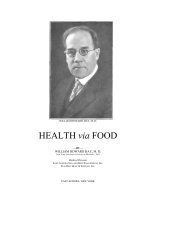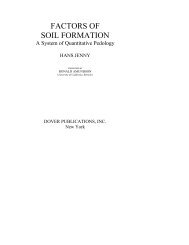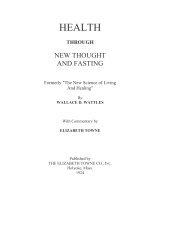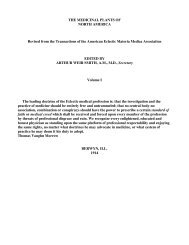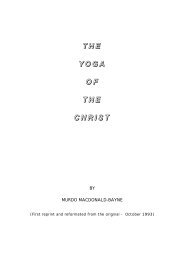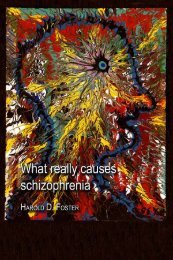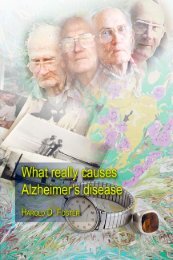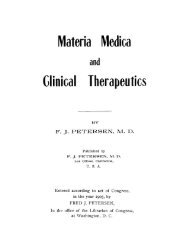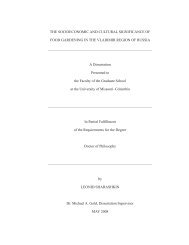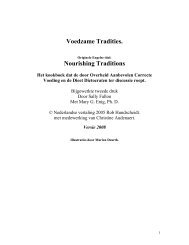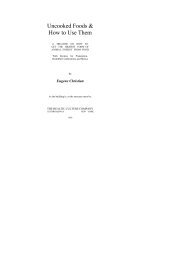historical and scientific perspectives on the health of canada's first ...
historical and scientific perspectives on the health of canada's first ...
historical and scientific perspectives on the health of canada's first ...
Create successful ePaper yourself
Turn your PDF publications into a flip-book with our unique Google optimized e-Paper software.
Speaking <strong>of</strong> peoples who <strong>on</strong>ce pursued or still pursue <strong>the</strong>ir<br />
traditi<strong>on</strong>al lifestyles, it can be said that “relative freedom from<br />
degenerative disorders or diseases was, <str<strong>on</strong>g>and</str<strong>on</strong>g> still is,<br />
characteristic <strong>of</strong> all societies <strong>of</strong> hunter-ga<strong>the</strong>rers… [<str<strong>on</strong>g>and</str<strong>on</strong>g>] in<br />
<strong>the</strong> societies <strong>of</strong> hunter-ga<strong>the</strong>rer agriculturalists.” This remains<br />
true despite notable differences in plant-animal subsistence<br />
ratios <strong>of</strong> various indigenous peoples. 16<br />
Canada’s <strong>first</strong> peoples who practiced agriculture relied heavily<br />
<strong>on</strong> <strong>the</strong> planted maize, beans, squashes, pumpkins, <str<strong>on</strong>g>and</str<strong>on</strong>g> mel<strong>on</strong>s<br />
<strong>of</strong> <strong>the</strong> fields, <str<strong>on</strong>g>and</str<strong>on</strong>g> <strong>the</strong> peach orchards. Additi<strong>on</strong>ally, <strong>the</strong> wild<br />
grass, seeds, nuts, fruits, <str<strong>on</strong>g>and</str<strong>on</strong>g> roots <str<strong>on</strong>g>and</str<strong>on</strong>g> <strong>the</strong> products <strong>of</strong> <strong>the</strong> traps<br />
or <strong>the</strong> chase supplemented <strong>the</strong>ir diet, whereas <strong>the</strong> latter nutrient<br />
supplementals served as <strong>the</strong> primary food sources for <strong>the</strong> more<br />
strictly hunter-ga<strong>the</strong>rer peoples. 17 Am<strong>on</strong>g all tribal peoples <strong>the</strong><br />
knowledge <strong>of</strong> <str<strong>on</strong>g>and</str<strong>on</strong>g> ability to identify, ga<strong>the</strong>r, prepare <str<strong>on</strong>g>and</str<strong>on</strong>g> utilize<br />
<strong>the</strong> edible <str<strong>on</strong>g>and</str<strong>on</strong>g> <strong>the</strong> healing plants <strong>of</strong> <strong>the</strong> envir<strong>on</strong>ment was<br />
comm<strong>on</strong>ly passed down from <strong>the</strong> parents to <strong>the</strong> children.<br />
19 th Century Prairie<br />
Through successive generati<strong>on</strong>s this traditi<strong>on</strong>al knowledge <strong>of</strong> plant varieties <str<strong>on</strong>g>and</str<strong>on</strong>g> uses grew <str<strong>on</strong>g>and</str<strong>on</strong>g><br />
exp<str<strong>on</strong>g>and</str<strong>on</strong>g>ed. Am<strong>on</strong>g <strong>the</strong> agriculturists <strong>the</strong>re is evidence that <strong>the</strong>se peoples understood such<br />
principles <strong>of</strong> modern agricultural <str<strong>on</strong>g>and</str<strong>on</strong>g> plant science as crop rotati<strong>on</strong>, organic fertilizati<strong>on</strong> <str<strong>on</strong>g>and</str<strong>on</strong>g><br />
photosyn<strong>the</strong>sis. Additi<strong>on</strong>ally in virtually all geographic regi<strong>on</strong>s <strong>the</strong>re was an apparent practical<br />
knowledge <strong>of</strong> <strong>the</strong> body's nutriti<strong>on</strong>al needs for various vitamins <str<strong>on</strong>g>and</str<strong>on</strong>g> mineral elements, <str<strong>on</strong>g>and</str<strong>on</strong>g> how to<br />
obtain <strong>the</strong>m. This included <strong>the</strong> use <strong>of</strong> supplemental foods rich in Vitamin C (for scurvy), Vitamin<br />
A (for xeropthalmia), Vitamin D (for rickets), al<strong>on</strong>g with o<strong>the</strong>r nutrient supplements for<br />
increased fertility <str<strong>on</strong>g>and</str<strong>on</strong>g> improved gestati<strong>on</strong>. 18<br />
With a traditi<strong>on</strong>al way <strong>of</strong> life closely in harm<strong>on</strong>y with <strong>the</strong> natural world, <strong>the</strong> physical<br />
development <strong>of</strong> North America’s <strong>first</strong> peoples were remarkably parallel to <str<strong>on</strong>g>and</str<strong>on</strong>g> reflective <strong>of</strong> <strong>the</strong>ir<br />
social <str<strong>on</strong>g>and</str<strong>on</strong>g> spiritual life. It is becoming increasingly understood that man's psychological <str<strong>on</strong>g>and</str<strong>on</strong>g><br />
spiritual c<strong>on</strong>diti<strong>on</strong> forms <strong>the</strong> essential underpinning <str<strong>on</strong>g>and</str<strong>on</strong>g> motivating force for <strong>the</strong> integrated<br />
development <str<strong>on</strong>g>and</str<strong>on</strong>g> sustenance <strong>of</strong> his physical, mental <str<strong>on</strong>g>and</str<strong>on</strong>g> societal <strong>health</strong>. The body was regarded<br />
as a temple <strong>of</strong> <strong>the</strong> spirit <str<strong>on</strong>g>and</str<strong>on</strong>g> up<strong>on</strong> this truth was built a rigid system <strong>of</strong> physical training, <str<strong>on</strong>g>and</str<strong>on</strong>g> a<br />
social <str<strong>on</strong>g>and</str<strong>on</strong>g> moral code that was c<strong>on</strong>sidered <strong>the</strong> law <strong>of</strong> life. There was aroused in children <str<strong>on</strong>g>and</str<strong>on</strong>g><br />
youth a high ideal <strong>of</strong> physical strength <str<strong>on</strong>g>and</str<strong>on</strong>g> beauty, <strong>the</strong> attainment <strong>of</strong> which depended <strong>on</strong> strict<br />
self-c<strong>on</strong>trol in eating <str<strong>on</strong>g>and</str<strong>on</strong>g> in sexual relati<strong>on</strong>s, toge<strong>the</strong>r with severe <str<strong>on</strong>g>and</str<strong>on</strong>g> persistent exercise. He/she<br />
was required to fast from time to time <str<strong>on</strong>g>and</str<strong>on</strong>g> to engage in hard running, swimming <str<strong>on</strong>g>and</str<strong>on</strong>g> vapour<br />
bathing in sweat lodges. 19<br />
For sheer physical endurance <strong>the</strong> indigenous peoples <strong>of</strong> <strong>the</strong> Americas were <str<strong>on</strong>g>historical</str<strong>on</strong>g>ly without<br />
peer, attaining a level <strong>of</strong> vigour <str<strong>on</strong>g>and</str<strong>on</strong>g> strength that would put to shame <strong>the</strong> strength <str<strong>on</strong>g>and</str<strong>on</strong>g> power <strong>of</strong><br />
civilized man. The most famous runner <strong>of</strong> ancient Greece was Pheidippides whose record run<br />
from A<strong>the</strong>ns to Sparta was 140 miles in 46 hours. Set<strong>on</strong> menti<strong>on</strong>s that he saw a young Cree who<br />
<strong>on</strong> foot had just brought in dispatches from Fort Qu’ Appelle 125 miles distant in <strong>on</strong>ly 25 hours.<br />
“I heard little from <strong>the</strong> traders but cool remarks like ‘a good boy,’ ‘pretty good run’. It was<br />
6



